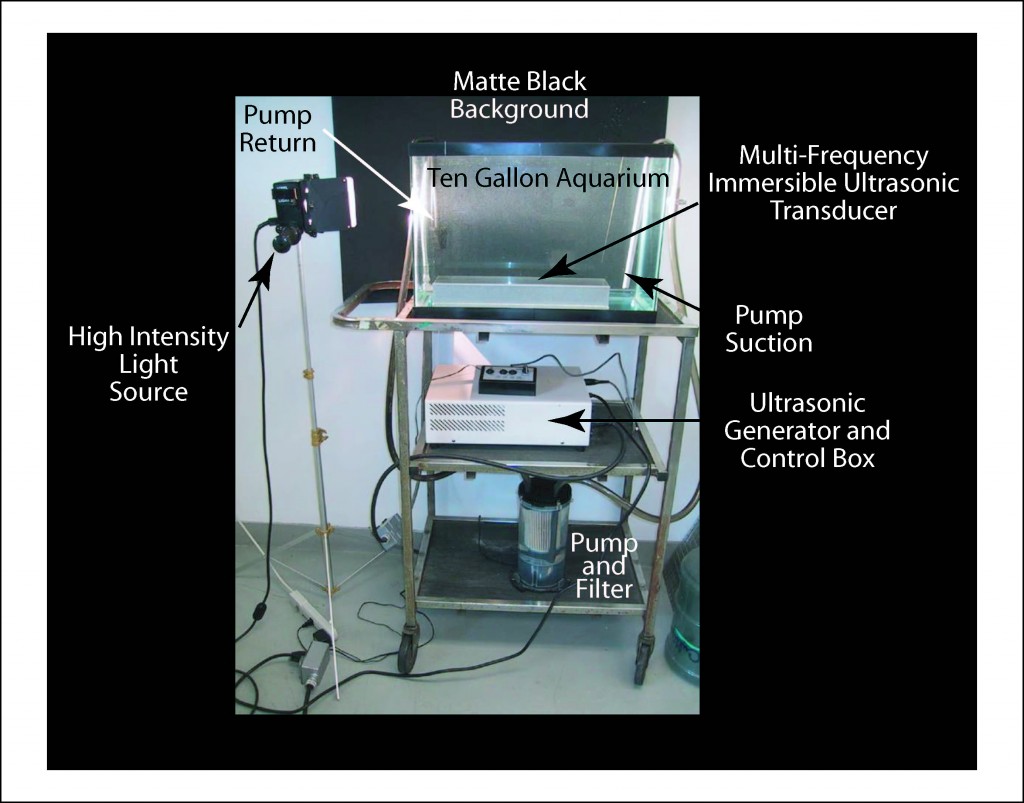It occurred to me several years ago that when we look at an ultrasonic cleaning tank, we are usually looking in from the top. I wondered how ultrasonics looked from a “fish eye” view which spawned (get it?) what is now called the ultrasonic fish tank in our Jamestown, NY laboratory. In upcoming blogs, I will be posting a number of videos showing various underwater effects of ultrasonics including degassing, cavitation, cleaning and a host of other cool things. This blog describes how the laboratory fish tank rig is configured and some of the challenges that needed to be overcome to make it useful in studying the underwater effects of ultrasonics close up.
When viewed from the top of an ultrasonic cleaning tank, anything that might be seen under the surface of the water is distorted by surface effects on the water including ripples, bubbles and reflections of light from the surface. Not satisfied with what I could see from above, I embarked on a project to see in clear detail what was happening under the surface of an ultrasonic tank. The fish tank rig was the result. The fish tank is really just a 10 gallon glass aquarium mounted on a lab cart. A small, multi-frequency immersible ultrasonic transducer was placed on the glass bottom of the fish tank and tested. I had concerns about what effects ultrasonic activity might have on the glass aquarium so I took things rather slowly at first. In initial operation, the ultrasonic power was limited to a fraction of the capability of the transducer and generator but I soon learned that the aquarium was more robust than I had anticipated. The ultrasonic power was increased to utilize the full capability of the ultrasonic generator which is about 600 watts.

In order to see what was happening within the tank, I added a matte black background and a high intensity light source. The first light source, a 150 watt spotlight bulb placed close to the side of the tank, caused the glass side wall to crack due to thermal stress. After first replacing the aquarium, a light source providing about 500 watts of illumination was substituted for the spotlight bulb and was placed at a sufficient distance from one side of the tank to prevent cracking of the glass due to thermal stress. The selected light source is a fixture commonly used for photography and has focusing capability as well as “barn doors” to direct the light as required to see different ultrasonic effects.
It became obvious early on that contamination of the water in the tank was going to be a problem even though nothing was really being cleaned in it. “Scum” formed rapidly in the warm, de-ionized water environment. A pre-coat filter using diatomaceous earth (actually an aquarium filter) was added which keeps the water in the tank crystal clear.
Finally, once it was determined that there were things to be seen, a digital video camera was added to record experiments conducted in the fish tank. At first there was a bit of a problem with the video camera picking up reflections from the room including ceiling lights and windows. The ceiling lights, of course, could be turned off during testing but a black shield was required behind the camera to prevent reflections from the windows interfering with the view. An additional black mask is used to prevent reflections from the camera and the lens which has a narrow silver ring around its perimeter.
Even though the aquarium seems resistant to ultrasonic activity, I avoid temperatures above 120F and strictly limit chemical use in the tank. Some studies have been done with mild detergents and surfactants but heavy-duty chemicals are forbidden at least for the time being.
Predictably, just as with any new scientific tool, the fish tank studies to date have created more questions than answers. The quest continues to both see and prove what we already think is fact and to put fact to what we see that has never been explored before. Watching the tank can be just as mesmerizing as watching pet fish in an aquarium which brings the inevitable question, “Have you tried to see what effect ultrasonics might have on fish?” The answer is NO! I have not and do not intend to subject living fish to high intensity ultrasonic waves. My guess is that high intensity ultrasounc would be painful if not fatal to marine life.
– FJF –



 English
English Spanish
Spanish Chinese
Chinese Canada
Canada Mexico
Mexico United Kingdom
United Kingdom




4 comments on “The Ultrasonic Fish Tank in the Lab”
Mike –
Thanks! I am having fun doing it and I, as you, can’t wait to see what I’ll come up with next. There will be some video within the next week. I promise.
John Fuchs
Hank –
Thank you for the comments. I enjoy doing it. If customers have questions, be sure to get them to me. Thanks.
John
I enjoy your blog posts John, and look forward, with great interest, to the upcoming videos.
Great stuff John. I’m looking forward to more from the fish tank. I wanted you to also know you are getting some good reviews from our customers on your blogs. Keep up the good work.